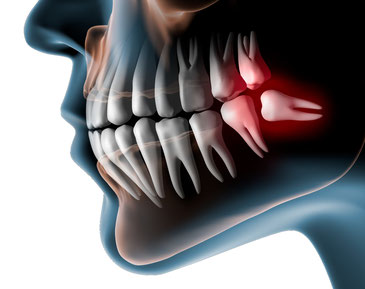Not every wisdom tooth has to be removed. However, it turns out that most upper and lower jaws are too small for wisdom teeth. This lack of space can cause a feeling of pressure or even pain and inflammation.

After a detailed diagnosis, our oral and maxillofacial surgeon, doctor and dentist Dr. med. Thomas Franke will carry out the ambulant removal of wisdom teeth in a pleasant atmosphere in our practice. We are specialised in the holistic treatment of our patients and pay particular attention to minimally invasive and gentle removal. State-of-the-art diagnostic procedures also allow for a safe removal of wisdom teeth and our holistic treatment concept ensures the best possible wound healing and a quick recovery of our patients.
When is the removal of wisdom teeth necessary?
Wisdom teeth remain in the jaws of some people for life, in others they grow out in their teens and in some people they are not there at all. However, once a wisdom tooth breaks through, it can be extremely painful. It is not always necessary to remove the wisdom teeth, as long as they break through in the correct position and with enough space. In any case, the necessity of wisdom tooth removal must be assessed individually.
As the wisdom teeth are the last to break through in the dentition, in many cases there is no space left in the row of teeth at this point. It has also been shown that most upper and lower jaws are too small for the wisdom teeth. This lack of space can cause the wisdom teeth to break through in the wrong place or even grow horizontally instead of vertically, thus damaging the neighbouring molars. The pressure that arises can also displace other teeth. And it is also possible that the mucous membrane between one wisdom tooth and the neighbouring cheek tooth is squeezed, which in turn can lead to painful inflammation.
Most patients then describe symptoms such as pain and inflammation behind the last molars. Frequently, an expected crowding is already noticeable during orthodontic treatment.
In order to avoid damage or to remedy complaints, in these cases the wisdom teeth are removed as gently and minimally invasively as possible after a careful diagnosis.
What is the exact procedure for wisdom tooth removal?
The removal (extraction) of the wisdom teeth takes place in an outpatient procedure in our practice in Berlin Charlottenburg.
Before the procedure
Before the procedure, a careful examination of the area in question and the dentition is carried out. In some cases, it may be advisable to carry out an exact clarification using digital volume tomography (DVT), which allows an extremely detailed image of the condition and position of the wisdom tooth and neighbouring structures without any overlapping.

DVT is an ultra-modern X-ray procedure that enables high-resolution, three-dimensional imaging of the head and face, including the jaws and sinuses, with low radiation exposure.
DVT can be used to precisely determine the length and shape of the wisdom tooth including the roots as well as the course of nerves and other neighbouring structures. Thus, a necessary removal of the wisdom tooth can be planned exactly. This procedure also allows possible complications to be taken into account so that a risk-minimised intervention can be carried out.
Finally, in a personal conversation with Dr. med. Thomas Franke, pre-existing conditions, the general condition and special circumstances as well as possible fears and wishes are discussed in detail. In this conversation, Dr. med. Thomas Franke also clarifies the exact procedure, the type of anaesthesia and the aftercare with the patient.
The intervention
The removal of wisdom teeth is carried out by Dr. med. Thomas Franke in a pleasant atmosphere as an outpatient in our practice. Of course, we also take into account existing fears of our patients and offer – if necessary and desired – assistance and alternatives.
First of all, the area in question is anaesthetised using gentle methods so that pain is completely eliminated during the procedure. After a sufficient waiting period, the affected area is completely anaesthetised, and the patient then no longer feels any pain during the procedure.
As a rule, the pain is eliminated by local anaesthesia. For anxious patients and in special cases, the procedure can also be performed in twilight sleep or under general anaesthesia. This is discussed in detail with the patient in advance.
If the anaesthesia works reliably, the operation can be started. In the first step, the gum is detached from the tooth at the affected area so that the root is exposed. The tooth and its root can then be removed from the tooth socket. If the wisdom teeth are trapped in the bone or even hidden, the surgical procedure becomes more complex. As an oral and maxillofacial surgeon and thanks to his many years of experience, Dr. med. Thomas Franke is able to carry out even complicated procedures as safely and minimally invasively as possible thanks to the detailed preliminary examination.
Afterwards, the wound formed by the removed tooth is cleaned and usually closed by a fine mucous membrane suture.
If desired, treatment with the PRP method can also be carried out in the wound area. This is an autologous blood therapy that accelerates wound healing and minimises osseous inflammation.
After the operation
After the removal of the wisdom tooth and careful wound care, we prepare an individually tailored medication schedule for our patients, which should be followed without fail in the days following an operation. In this way the development of pain can be largely contained. We also stabilise our patients’ immune systems and help to achieve optimal healing results and rapid regeneration after the operation.
What happens after the removal of the wisdom tooth?
In addition to the individually tailored medication regimen against the pain and for the optimal care of the immune system, we also give our patients further recommendations for the days following the procedure.
For example, the cheek should be sufficiently cooled in the operated area. In addition, sufficient protection should be provided, especially 24 hours after an operation. We also recommend that our patients only eat soft foods such as soups and porridge. However, food containing grains or especially crusty food should be avoided, as they can become embedded in the surgical wounds and cause inflammation.
Sports activities should also be avoided in the first few weeks to prevent secondary bleeding. Avoiding coffee, caffeine, alcohol and tobacco also promises a better healing process.
The stitches are removed after about a week at a check-up appointment.
Is the removal of the wisdom tooth painful?
During the removal of the wisdom tooth, our patients do not feel any pain, as the affected area is sufficiently and reliably anaesthetised. After the procedure, slight to moderate pain can be expected, which only lasts a few days and can be reduced with painkillers. We also recommend that the affected cheek area be cooled sufficiently.